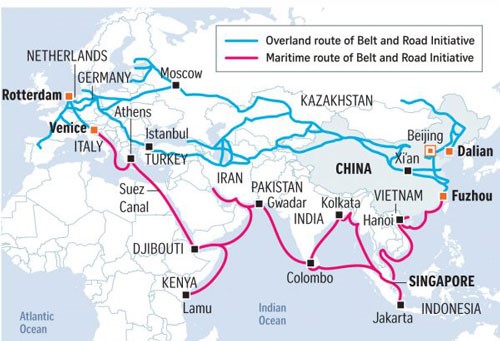
Overland and maritime route of Belt and Road Initiative (BRI)
Source: Pakistan Observer
Anmerkung der Bundesfachkommission:
Der folgende englischsprachige Beitrag wurde mit freundlicher Genehmigung des Autors als Debattenbeitrag zur Verfügung gestellt (Erstveröffentlichung: Green BRI: Reality or Mirage | By Dr Mehmood Ul Hassan Khan – Pakistan Observer (pakobserver.net)). Der Beitrag gibt die persönliche Sichtweise des Autors wieder. Die Bundesfachkommission „Neue Seidenstraße“ des BWA bemüht sich um ein breites Meinungsspektrum und Debattenbeiträge zur eigenständigen fundierten Meinungsbildung.
View from Pakistan: Green One Belt One Road Initiative (BRI): Reality or Mirage?
December 9, 2021, Dr. Mehmood Ul Hassan Khan – Member of the Board of Experts of the Center for Global and Strategic Studies (CGSS) in Islamabad, Pakistan
One Belt One Road Initiative (BRI) is making difference in the regional as well as at the global level in terms of greater regional connectivity, socio-economic integration, infrastructural development, poverty eradication and new job generation in all the participating countries. It has become global “engine” of economic stability and future “sustainability”.
At its eight year there are lots of speculations going on in the US and the West about BRI strategic importance, utility, performance, productivity and participatory orientation.
On the other hand, the most recently published report of the China State Council (September 2021) entitled, ‘Responding to Climate Change’, projects Chinese achievements on pollution controls, structural policies to discard coal energy production and consequently moving away from coal, CO2 reductions and building a ‘Belt and Road South-South Cooperation Initiative’ finalized specifically to tackle climate change and slow down the warming of the planet. Hopefully, China’s strong commitment and striving hard spirit to a greener and more sustainable BRI will help tackle global climate change challenges.
According to this report, China also plans to create a Belt and Road Energy Partnership (BREP). It states that China is working with relevant countries to facilitate actions on “ecological conservation” and climate change. So Green BRI is reality not mirage. Furthermore, numerous projects of the original BRI have already been transformed into greening which will all come under the sustainability principles enshrined in the 2021 partnership for green development.
The said report upholds that in 2021, China and 28 other countries launched the Initiative for Belt and Road Partnership on Green Development which vividly reflected that climate change could be managed through concrete actions guided by the principles of equity and common but differentiated responsibilities and respective capabilities, weighted against different national circumstances.
Interestingly, the full report was published just days before the COP26 UN climate summit in Glasgow, indicates China’s sincere efforts to cut emissions and gradually moving away from coal by using sustainable technology in everything from city planning to protect biodiversity.
In this context, China instruments its holistic approach to global climate governance through building a green silk road. It promotes green development and is working with relevant partners to build a green silk road. It values an active response to the challenges of climate change and urges for closer results-oriented cooperation in implementing the Paris Agreement and in other areas.
According to this report, China’s balance of green loans amounted to RMB11.95 trillion ($1.9 trillion), of which the clean energy loan balance was RMB3.2 trillion ($500 billion) on December 31, 2020.
China has issued a total of about RMB1.2 trillion of green bonds ($188 billion), with roughly RMB800 billion ($125 billion) outstanding, making it the world’s second-biggest green bond market which clearly illustrates it strong commitment towards green BRI in the days to come.
The new Chinese guidelines are soft law which have already sent a clear signal to all the main stakeholders, policy makers and financial institutes like China Development Bank, China Export-Import Bank and Sinosure, China’s export credit insurance agency to invest in green BRI projects. This policy gives a boost to their efforts to go green and helps set their expectations that stricter measures are likely to follow.
In addition to this China’s carbon intensity in 2020 was 18.8 per cent lower than that in 2015, a better result than the binding target set in the 13th Five-year Plan (2016-2020). The figure was also 48.4 per cent less than that in 2005, which means that China had more than fulfilled its commitment to the international community to achieve a 40-45 per cent reduction in carbon intensity from the 2005 level by 2020.
Non-fossil energy contributed 15.9 per cent to China’s total energy consumption in 2020, a significant increase of 8.5 percentage points compared with 2005.
The total installed capacity of non-fossil energy power generation in China reached 980 million kW, accounting for 44.7 per cent of total installed capacity, according to the report.
Of that, wind represented 280 million kW, PV 250 million kW, hydro 370 million kW, biomass 29.52 million kW and nuclear power 49.89 million kW. Electricity generated by non-fossil energy represented more than one third of the power consumption of the country.
The State Council report shares that climate change is a challenge for all of humanity. The sustainable development of the Chinese nation and the future of the planet depend on tackling it successfully.
In 2013, President Xi Jinping unveiled the BRI. Some 165 countries and 32 international organisations, including 19 UN agencies, have since signed Belt and Road cooperation documents with China.
China now pursues a philosophy that development must be innovative, coordinated, green, open and shared, and accelerates the pace in creating a new development dynamic.
Most recently, the “Green Development Guidelines for Overseas Investment and Cooperation”, issued jointly by the Ministry of Commerce (MOFCOM) and the Ministry of Ecology and Environment (MEE), supports Chinese businesses to integrate green development throughout the overseas investment process. They both also suggest that companies should follow international green rules and standards.
Thus they represent a gradual moving from coal production that could pave the way for the implementation of much higher standards in infrastructure projects under the BRI.
The guidelines call for strengthening engagement with host country environmental protection organisations. They also name non-fossil energy technologies as key areas for investment. Thus green BRI is reality not mirage as dubbed by the US and the West.
The guidelines are comprehensive, covering climate, biodiversity and pollution. Specifically, they urge to foster the “green development concept” throughout the entire process of foreign direct investment and cooperation.
They encourage the practice of environmental impact assessments and due diligence in accordance with internationally accepted standards.
They are ready to apply high standards at the planning and design phase of infrastructure projects and strengthen contact with host country governments, media, local people and environmental protection organisations and last but not the least, support investment in solar, wind, nuclear and biomass energy and other forms of clean energy.
To conclude, there is an urgent need to even rectify imbalance of energy production mechanism in the CPEC too. More investment should be made in green energy projects, especially in hydropower, wind, solar and biomass.
About the author

Source: Dr. Mehmood Ul Hassan Khan
Dr. Mehmood Ul Hassan Khan was born 1969 in Lahore, Pakistan. He completed his M.Phil. leading to Ph.D. in 2010 from University of Punjab, Pakistan in Development. He has vast experience in serving different departments of the Federal Government. He worked in BBC Asia Network as regional expert on Afghanistan and Middle East in 2004. His research and comprehensive articles have already been published in China, Uzbekistan, Iran, Turkey, Azerbaijan, USA, South Korea, UAE and Kuwait. His research focuses on the socio-economic, geo-political and geo-strategic issues of Central Asia, Caucasus and Middle East. Dr. Khan ist also Member of the Board of Experts of the Center for Global and Strategic Studies (CGSS) in Islamabad, Pakistan.

